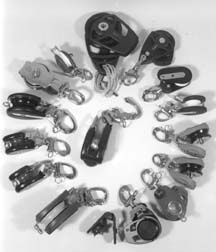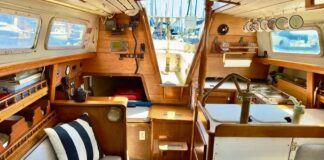No hardware aboard a boat is as ubiquitous as a snatch block. They’re expensive and not the strongest piece of gear used for running rigging. However, the appeal of snatch blocks is that they can move around the boat, stopping anywhere they’re needed.

They get fastened with snap shackles, “D” shackles (plain, long or twisted), strops, webbing, bridles or lashings—to anything that’s in a position to facilitate the odd hauling job at hand.
Most typically, snatch blocks, attached to the toe rail, a padeye or track car, are used on cruising boats to control the spinnaker. When the air is light, they make a terrible racket banging on the deck. So, they often have rubber, PVC or urethane covers on the cheeks or, even better, have beckets or simple eyes to attach shock cord strops (led up to a lifeline) to keep them from driving the off watch berserk.
Attached to the boom bail or a saddle, they can hoist aboard a human or a dinghy. Snatch blocks also can serve in anchoring situations, sometimes positioned to prevent chafe. And, of course, they can change line leads on anything.
If the snap shackle used for attachment is a good one, the swinging arm will open easily and have a proper chamfer to actuate the spring-loaded pin and then permit it to lock home.
The snap shackle works in concert with a swivel post to keep all leads fair. It works even better with what somebody chose to call a “trunnion,” which means that the shackle pin itself is a hinge. (A real trunnion is the pins on either side of an old-fashioned cannon that permit it to tilt up and down.)
The shackle trunnion, combined with a swivel post, becomes a universal joint, precluding the snatch block from getting caught with its knickers in a twist. It doesn’t like loads improperly applied and if abused can fail suddenly and dangerously.
The great appeal of the snatch block is, of course, that it can be put in place, opened to place a bight of line in what is called the “swallow” (the space through which the line runs) and closed. Even a line under some load can be forced into the swallow. There’s no need to chase down and reeve the bitter end.
Snatch blocks are not made as strongly as regular blocks. There are more moving parts. If you want a snatch block to do a heavyweight job, use a big one. There is a real brute in this report. Just always be aware of their safe working loads, as specified by the manufacturer.
Among their other less endearing features is that both the block and the shackle can be difficult or impossible to open when under a load. Even worse, they have been known (usually when shaken, as in violent slatting) to open inadvertently.
Also, a snatch block often is said to like only line that makes obtuse angles (more than 90°, less than 180°). However, they often are used as turning blocks or in a block and tackle. If large enough, there’s no problem.
A New Look
Practical Sailor’s last thorough examination of snatch blocks was published almost eight years ago in the July 15, 1992 issue. There were then but five manufacturers—Barton and Lewmar in England; Nicro and Ronstan in Australia and Schaefer, of the United States.
Near the end of that report was the statement, “…up in Pewaukee, Wisconsin, Harken engineers have their heads down working on snatch blocks, heretofore not included in the firm’s extensive line of blocks.”
Three years later, we reported on both the new Harken push-button snatch block and, lo and behold, a new Nicro (now called Ronstan). Both were deemed admirably innovative, with the Harken getting the comparative nod.
Late last year, Wichard, the respected French firm, introduced a snatch block based on an approach different enough to earn a patent.
Even more recently, Garhauer, the California hardware maker, offered to send for evaluation its brand new snatch blocks, and we discovered that Suncor, the stainless steel fabricator, makes an all-stainless snatch block; Antal, the Italian manufacturer, has yet another way to do it, copied from Barton, the old-line UK maker of economical hardware.
Plainly, it is time to line up all 11 makes on the workbench. In alphabetical order, they’re from Antal, Barton, Garhauer, Harken, Holt-Allen, Lewmar, Nicro, Ronstan, Schaefer, Suncor and Wichard.
Some are light duty; others are rugged. To operate, some require two hands (and strong ones to boot); some are one-handed child’s play. Some are cranky; some smooth as silk.
Let’s divide them into two groups—traditional and modern.
A Base Model
Our old #3 Merriman (see photo previous page) has been used afloat and ashore for all sorts of tasks. Most recently it was lashed to a piling to serve as a turning block while testing anchors. Considering that it weighs almost 3 lbs. and will handle 3/4″ line, the Merriman block has a 1-1/2″-diameter stainless sheave. The cheek straps, beefed out with black rubber, are doubled over stainless steel strips that are 3/16″ thick. One ear of the rubber cheeks serves as the spring for the gate latch. The folded straps are the hinges over which the cast SS slotted gate fits. The gate (which technically is a hasp) also contains the snap shackle’s swivel. Although heavily built, the mechanism is a very sloppy fit. In any position, it can be opened easily with one hand by depressing the swivel/shackle end and flipping out the latch with a thumb or forefinger. It’s equally easy to close, except for the chrome-plated bronze snap shackle (which demands that you pull back the pin).
It is typical of snatch blocks used aboard boats for many years.
Conventional Designs
Almost identical in principle to the old Merriman are the Barton cruiser blocks, Lewmar, a Nicro Marine (now sold by Ronstan, who bought part of Nicro some time ago) and the Schaefer.

Barton appears to have had cost strongly in mind when it designed its line of snatch blocks for one-designs and medium-sized cruising boats. The cruising blocks, long-proven designs that will take a working load up to 1,385 pounds, are conventional top-opening blocks that don’t open easily. They have built-in beckets. There is a choice of shackles. The smaller Bartons will be discussed later in this review.
The other British manufacturer, Lewmar, makes a very complete line of snatch blocks—four sizes, all with beckets, all with either ball or needle bearings. They are available with swivel shackles or D shackles, but Lewmar does not offer trunnion snap shackles. If free movement is required a shackle must be interposed to provide full articulation.
All of the Lewmars have stainless load-bearing straps and aluminum cheeks cushioned with either gray rubber (the two small sizes) or nylon (the larger versions). The small ones have Delrin sheaves and stainless ball bearings; the large ones have aluminum sheaves and needle bearings.
The Lewmar snatch blocks are quite modern in appearance and can be dismantled for repairs. The shackles and the blocks themselves are moderately difficult to open but snap closed easily.
The Nicro blocks also come in four sizes, with a good choice of trunnion or swivel shackles and white or black PVC-coated cheeks. The small sizes have plain stainless bearings and Delrin sheaves, the bigger ones have ball bearings and aluminum sheaves.
The Nicro blocks use the popular Nicro snap shackles (which are used on some other makes of snatch blocks). Traditional in appearance, they are a bit more difficult to open than the Lewmars. They snap closed fairly easily.
Schaefer makes three sizes of snatch blocks and what makes them unusual are the ball joints in the shackle and the fiberglass-reinforced Nomex™/Teflon™ sleeve bearings in the two larger models.
The Schaefer ball joint permits 15° of movement in any direction, which will satisfy most alignment requirements. Nevertheless, like Lewmar, Schaefer warns that if any doubt exists, use a D shackle.
Although a Schaefer sheave may not spin as freely as one riding on ball or needle bearings, Schaefer’s high-tech bearing is more maintenance-free and probably will outlast ball or needle bearings when high loads and shock loads are imposed. Schaefer is so confident that it’s two larger blocks have sheaves locked in with axles with rolled collars.
On the negative side, the Schaefer snatch blocks and shackles are very difficult to open; they close only slightly easier.
Newer Approaches
Let’s look now, in alphabetical order, at innovations of the last several years—by Antal, Garhauer, Harken, Holt-Allen, Ronstan, Suncor and Wichard.
It should be noted that the revolving cheek system used by two of these innovators (Antal and Garhauer) appears to have been used for some time by Barton, but only on its small one-design blocks. The English manufacturer offers two sizes of lightweight snatch blocks (with “D” shackles or snaps) that open via one rotating cheek. Very easy to operate, it is held closed by a simple detent. The safe working load is about 400 pounds.
Most everything made by Antal is not only first-rate quality, but also handsomely designed…and the Italian manufacturer’s big snatch blocks are good examples.
When a spring-loaded locking pin is lifted, one black-anodized cheek plate is free to revolve on the stainless axle, thus opening up the block to drop a bight of line over the black acetal resin sheave, which rides on Delrin bearings. The release pin is small and stiff to preclude inadvertent opening. For security, the revolving cheek fits in a groove in the body of the block.
The two sizes are available with “D” shackles, Wichard’s forged snap shackles or for attachment with webbing or line. Peculiarly, they have no beckets.
The Antals are smooth…and expensive.
By contrast, Garhauer’s new snatch blocks are simple, strong and cheap. Also offered in two sizes, the Garhauers use the same revolving cheek freed by a locking pin. The hinged cheek does not, however, have Antal’s reinforcing grooved fit.
Offered with plain or Nicro’s trunnion shackles, the Garhauers have beckets affixed to the big stainless axles and have expensive Torlon bearings. They are as smooth to operate as the Antals. These snatch blocks are based on the company’s “Light” or hollow block design and cannot be disassembled. However, as with other Garhauer gear, they carry an unconditional 10-year guarantee. They are available in titanium; just add 50% to the price. (Incidentally, all Garhauer blocks are available in titanium for the same price differential, a terrific bargain compared to competing brands. We’ve had some on Viva’s mainsheet tackle for several years; they’re light, strong and look great.)
Harken uses a different approach—a unique push-button mechanism that permits a hinged cheek to swing free of the sheave axle. A bight of line is inserted, in effect, from the bottom rather than the top.
Made of top-notch materials, the Harkens come with “D” shackles (Wichard) or trunnion snap shackles (Nicro), built-in beckets, urethane-padded cheeks and two sets of bearings—ball bearings for side loads and needles for sheave loads.
Made in Harken’s inimitable fashion, these snatch blocks come not in two sizes, but in two strengths. One is called standard; the other Hi-Load. They cannot be dismantled. They’re very easy to operate.
The little Holt-Allen snatch block is a marvel of simplicity. Like the Harken, it is hinged at the top and opens from the bottom. The locking latch is a simple strap that swivels to engage a notch in the axle.
Made of acetal resin with a resin sheave riding on Holt-Allen’s “cassette system” of stainless balls, the Holt-Allen has neither a shackle nor a becket. It is very stiff to open, but snaps closed fairly easy. For small boats and low-load applications, it’s worth consideration.
Ronstan’s Quick Latch snatch block might be viewed as a bridge between the old and the new. The Quick Latch was adapted from the Nicro block mentioned earlier. By redesigning the hasp of the Nicro, and equipping it with a lever-locking mechanism, Ronstan created a good piece of equipment.
Equipped with a trunnion shackle and becket, the Ronstan is a bit clap-trap looking, but it works fairly easily and, to its great credit, has a positive locking mechanism to keep it closed. It’s the only snatch block of the lot to have a deliberate safety feature.
Wichard’s new snatch blocks bear the unmistakable stamp of the French firm. Confident in the strength of the forging for which it is famous, Wichard hinges one stainless strap to permit it to release from the pull-pin sheave axle. The strap becomes a hasp.
The Wichard has a Wichard trunnion snap shackle, a becket, a plastic sheave, soft rubber cheeks and a self-lubricating bushing on the axle.
Most important, it works smooth as silk.
Finally, there’s the big all-stainless Suncor. It’s called a seine block. The block has a simple gate in the head to admit a bight of line. The gate, held closed by a spring, is very easy to operate.
Made more for work boats than sailboats, the Suncor comes with either a stainless eye or a hook, no padding, nothing fancy; just a fail-safe snatch block. It’s available also with a wire rope sheave.
Except for a brass bushing on the axle, it is made entirely of stainless steel, for which Suncor is noted. The company’s catalog is worth a look.
The Bottom Line
All of the old style snatch blocks—the Bartons, the Lewmars, Nicros, Schaefers—are much more difficult to operate than any of the newer designs. There’s nothing wrong with them; it’s just that the new ones are better.
Among the newer designs, the push-button Harkens, so much admired four years ago, now seem somewhat complicated, but are still easy to operate.
The Ronstan Quick Latches, fairly inexpensive, have the virtue of a positive lock but, in our view, deserve reworking to clean up a good design.
The Barton one-design blocks rate a Best Buy for a very small cruising boat, but check the working loads and note that they lack beckets. You might need a couple of thump pads.
Good-looking and the smoothest of all, the Wichard snatch blocks would be a good choice for a small to medium-sized boat.
Leaving the biggest and best for last, the Garhauers and Antals, both designed with one cheek pivoting on the axle, are outstanding. They are strong, clean designs. The Garhauers, as is so often the case, are the Best Buy.
The very refined Antals shine in every other category, but carry glaringly high prices.
Contacts- Antal, Euro Marine Trading, 62 Halsey, Newport, RI 02840; 401/849-0060. Barton, Imtra, 30 Samuel Barnet Blvd., New Bedford, MA 02745; 508/998-5359. Garhauer, 1082 W. Ninth, Upland, CA 91786; 909/985-9993. Harken, 1251 E. Wisconsin, Pewaukee, WI 53072; 414/691-3320. Holt-Allen, Jack Holt, Ltd., 177 Lynden, Lynden, ON LOR 1TO, Canada; 888/390-3242. Lewmar, 351 New Whitfield, Guilford, CT 06437; 203/458-6200. Nicro & Ronstan, 7600 Bryan Dairy Rd., Largo, FL 33777; 727/545-1911. Schaefer, 158 Duchaine, New Bedford, MA 02745-1293; 508/995-9511. Suncor, 7 Riverside Drive, Pembroke, MA 02359; 800/394-2222. Wichard, 507 Hopmeadow, Simsbury, CT 06070; 860/658-2201.





































